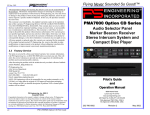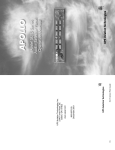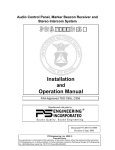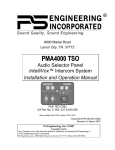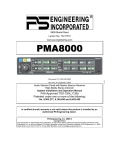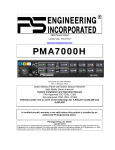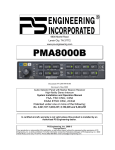Download PS Engineering PCD7100 Operating instructions
Transcript
9800 Martel Road Lenoir City, TN 37772 www.ps-engineering.com PCD7100-I Flying Never Sounded So Good!™ Pilot’s Guide and Operation Manual 202-791-0001 Revision 2 May 2004 High-fidelity Stereo Intercom System With Compact Disc Player (P/N 11950, 11951) or CD/MP3 Player (11956, 11957) FAA-Approved TSO C50c PCD7100-I Pilot Guide Rev. 2 1 GENERAL INFORMATION SCOPE This manual provides detailed operating instructions for the PS Engineering PCD7100-I Intercom Systems with integrated Compact Disc (CD) player (p/n 11950, 11951) or CD/MP3 Player (p/n 11956, 11957). Please read it carefully before using the equipment so that you can take full advantage of its capabilities. NOTE: Installation instructions are contained in Installation Manual, Part Number 200-971-xxxx, available from your authorized PS Engineering dealer, or at www.ps-engineering.com/pcd7100.shtml PUSH ONOFF INTERCOM VOLUME MUSIC VOLUME PUSH MUTE CONTROL INTERCOM MODE PLAY SKIP FWD SKIP BACK STOP EJECT PCD7100 controls 1.2 Power Switch (Fail Safe Operation) Unit power is turned on and off by pushing the intercom volume knob. In the OFF or "EMG" position, the pilot is connected directly to the aircraft radios. This allows communication capability regardless of unit condition. Any time power is removed or the unit turned OFF, the intercom will be placed in the fail-safe mode. 1.3 Intercom Operation 1.3.1 Intercom Volume Control The ICS volume control knob (left side) adjusts the loudness of the intercom for the pilot and copilot only. It has no effect on selected radio levels, music input levels or passengers' volume level. Adjust the radios and intercom volume for a comfortable listening level for the pilot. Most general aviation headsets today have built-in volume controls; therefore, passenger volume can be reduced at the headset. 2 Rev. 2 PCD7100-I -Pilot Guide 1.3.2 IntelliVox® VOX-Squelch No adjustment of the IntelliVox® squelch control is necessary. Through independent signal processors on each microphone, the ambient noise appearing in all microphones is constantly being sampled. Non-voice signals are blocked. When someone speaks, only their microphone circuit opens, placing their voice on the intercom. The system is designed to block continuous tones, therefore people humming or whistling in monotone may be blocked after a few moments. For best performance, the headset microphone must be placed within ¼ inch of your lips, preferably against them. It is also a good idea to keep the microphone out of a direct wind path. Moving your head through a vent air stream may cause the IntelliVox® to open momentarily. This is normal. For optimum microphone performance, PS Engineering, Inc. recommends installation of a leather Microphone Muff Kit from Oregon Aero (1-800-8886910). This will not only optimize VOX performance, but will improve the overall clarity of all your communications. If you experience clipping while using the IntelliVOX®, remove the foam mic cover. 1.3.3 CD Music and Soft Mute Control The right-side volume knob controls the loudness of the internal CD player. The volume knob controls the CD music volume only, it has no effect on the intercom or radio volume, or the secondary music input level. This knob is also the Soft Mute control for the CD player. Normally, the music is instantly muted during radio or intercom conversation, and returns gradually to full volume when conversation stops. Pushing the knob once will inhibit the soft mute, enabling a “Karoake” mode, where the music remains at he normal level for a sing-along. Push again to return to a soft muting mode. 1.3.4 Mono headsets in Stereo Installation Plugging a monaural headset into the pilot or copilot jacks has no effect other than there will be no stereo left and right separation. Since all passenger headsets are connected in parallel, if a monaural headset is plugged in to a PCD7100 Stereo installation, one channel will be shorted. Although no damage to the unit will occur, all stereo-equipped passengers will lose one channel. PS Engineering modifies headsets to add stereo capability, using highfidelity speakers. Contact factory for details (1-865-988-9800 or www.psengineering.com). 1.3.5 Intercom Modes On the left side of the intercom-versions is a 3-position mode switch that allows the pilot to tailor the intercom to best meet the current cockpit situation. ISO: (Up Position): The pilot is isolated from the intercom and is connected PCD7100-I Pilot Guide Rev. 2 3 only to the aircraft radio system. He will hear the aircraft radio reception (and sidetone during radio transmissions). Copilot and passengers will hear intercom and CD player. Neither will hear aircraft radio receptions or pilot transmissions. ALL: (Middle Position): All parties will hear the aircraft radio, CD music and intercom. During any radio or intercom communications, the music volume automatically decreases (unless the mute is inhibited). The music volume will gradually return to the original level after communications have been completed. Mode Pilot Hears Copilot Hears Passenger Hears Comments Isolate Radios Pilot Sidetone (during radio transmission) Copilot and passenger intercom CD player Passenger and Copilot intercom CD player This mode allows the pilot to communicate without the others bothered by the conversations. Copilot and passengers can continue to communicate and listen to music All Radios Sidetone Copilot Pilot Passengers CD Player Radios Sidetone Pilot Copilot Passengers CD Player Radios Sidetone Pilot Copilot Passengers CD Player This mode allows all on board to hear radio reception as well as communicate on the intercom. Music is muted during intercom and radio communications Crew Radios Sidetone Copilot Pilot CD Player Radios Sidetone Pilot Copilot CD Player Passengers Entertainment input 2 This mode allows the pilot and copilot to concentrate on flying, while enjoying music, while the passengers can communicate amongst themselves and enjoy an alternate music source CREW (Down Position): Pilot and copilot are connected on one intercom channel and have exclusive access to the aircraft radios. They may also listen to CD music. Passengers can continue to communicate with themselves without interrupting the Crew and also may listen to Entertainment 2. Entertainment 2 may be connected to the CD player during installation if so desired. 1.3.6 Secondary Entertainment Input The PCD7100 has provisions for an additional entertainment input. The primary music volume control does not affect secondary music level. While in the CREW mode, pilot and copilot will hear entertainment input #1 4 Rev. 2 PCD7100-I -Pilot Guide while the passengers may listen to entertainment input #2. It is also possible to use only one entertainment input device for both entertainment inputs. It is suggested however, that a switch (DPDT) is installed between the single entertainment device and entertainment input #1. This will allow the passengers to play the CD while in the Crew mode. 1.4 Operating the internal CD Player The single-disk CD player is designed for simple operation. There are five buttons with the following functions. 1 1 2 3 2 3 4 5 (Play) Plays CD, push again to pause (Jump Forward) Push to jump to the next track, hold to fast forward in current track (Jump Backward) Push to jump to the previous track, hold to rewind in current track 4 (Stop) Stops playback 5 (Eject) Ejects disc The CD player will begin to play automatically when a CD is inserted. Press the play button to pause the track. The jump forward button advances to the next track. Jump backwards selects the previous track. Stop ceases play, and Eject removes the disk from the CD player. 1.5 Internal Recorder System (P/N 11951, 11957 only) The Intercom Recording System (referred to here as the IRS) is a digital recording system allowing automatic storage and immediate playback of all incoming aircraft radio receptions. Operating as a continuous loop recorder, (first message received will be the last heard), the recorder has one minute of recording time divided into as many as 16 messages. With its own built-in VOX circuit, there are no butPCD7100-I Pilot Guide Rev. 2 5 tons to press to start recording. The system automatically begins to record the instant the radio becomes active. Only aircraft radio audio in pilot’s headset is recorded and only the pilot will hear the playback audio, in one ear. 1.5.1 Operation Recording is automatic; there is no action required by the pilot. To play back the last recorded message, simply press the momentary switch associated with the IRS. Each additional press of the button will play the preceding recorded message. To stop playback, hold the playback button for two seconds. The next push will then play the prior message. Creating MP3s on your home computer, from an Audio CD Start MusicMatch JukeBox.(www.musicmatch.com) Press the recorder button, which is the small red dot located in the top right corner. This will open the recorder window located at the bottom of the screen. Insert an audio CD into your computer’s CD drive. MusicMatch will automatically read the disc and display the contents in the recorder window. Press the REFRESH button to check the Internet database for CD information, such as artist, song title, or album. If this information is available, it will automatically be updated in the file. Select Options->Recorder->Format and select either MP3 or MP3PRO format. You may also set the MP3 file quality under the Options>Recorder->Quality menu. NOTE: For best results (reduced skipping, etc.) burn rate of the disc should not exceed the published rate of the media, or 2X, whichever is lower. Select the tracks to be copied to MusicMatch by checking the box next to the desired track. Press the record button in the lower left corner when complete MusicMatch will then convert the files from the audio CD to MP3 and display them in the Music Library box located in the middle of the screen. Warranty and Service 2.1 Warranty In order for the factory warranty to be valid, the installations in a certified aircraft must be accomplished by an FAA-certified avionics shop and authorized PS Engineering dealer. If the unit is being installed by a noncertified individual in an experimental aircraft, a factory-made harness 6 Rev. 2 PCD7100-I -Pilot Guide must be used for the warranty to be valid. PS Engineering, Inc. warrants this product to be free from defect in material and workmanship for a period of one (1) year from the date of installation as recorded in aircraft logbook and/or on FAA Form 337. During the twelve (12) months, PS Engineering, Inc., at its option, will send a replacement unit at our expense if the unit should be determined to be defective after consultation with a factory technician. All transportation charges for returning the defective units are the responsibility of the purchaser. All domestic transportation charges for returning the exchange or repaired unit to the purchaser will be borne by PS Engineering, Inc. The risk of loss or damage to the product is borne by the party making the shipment, unless the purchaser requests a specific method of shipment. In this case, the purchaser assumes the risk of loss. This warranty is not transferable. Any implied warranties expire at the expiration date of this warranty. PS Engineering SHALL NOT BE LIABLE FOR INCIDENTAL OR CONSEQUENTIAL DAMAGES. This warranty does not cover a defect that has resulted from improper handling, storage or preservation, or unreasonable use or maintenance as determined by us. This warranty is void if there is any attempt to dissemble this product without factory authorization. This warranty gives you specific legal rights, and you may also have other rights, which may vary from state to state. Some states do not allow the exclusion of limitation of incidental or consequential damages, so the above limitation or exclusions may not apply to you. All items repaired or replaced under this warranty are warranted for the remainder of the original warranty period. PS Engineering, Inc. reserves the rights to make modifications or improvements to the product without obligation to perform like modifications or improvements to previously manufactured products. 2.2 Factory Service The unit is covered by a one-year limited warranty. See warranty information. Contact PS Engineering, Inc. at (865) 988-9800 or www.ps-engineering.com/ support.shtml before you return the unit. This will allow the service technician to provide any other suggestions for identifying the problem and recommend possible solutions. After discussing the problem with the technician and you obtain a Return Authorization Number, ship product to: PS Engineering, Inc. Attn: Service Department 9800 Martel Rd Lenoir City, TN 37772 (865) 988-9800 FAX (865) 988-6619 Email: [email protected] NOTE: PS Engineering will not be responsible for any units shipped in the U. S. Mail. Any item received that does not have either an RMA or a detailed description of the problem AND a contact name and phone number will be refused. PCD7100-I Pilot Guide Rev. 2 7 NOTES PS Engineering, Inc. 2004 © Copyright Notice Copyrighted information in this manual is subject to change without notice. PS Engineering reserves the right to improve or change the products or contents of this manual, without notification of any person or agency. The contents of this pilot’s guide may be downloaded, stored and reprinted for personal use provided that this copyright information is included. Commercial use is strictly prohibited. For further information contact the Publications Manager at PS Engineering, Inc., 9800 Martel Road, Lenoir City, TN 37772. Phone (865) 988-9800 8 Rev. 2 PCD7100-I -Pilot Guide








